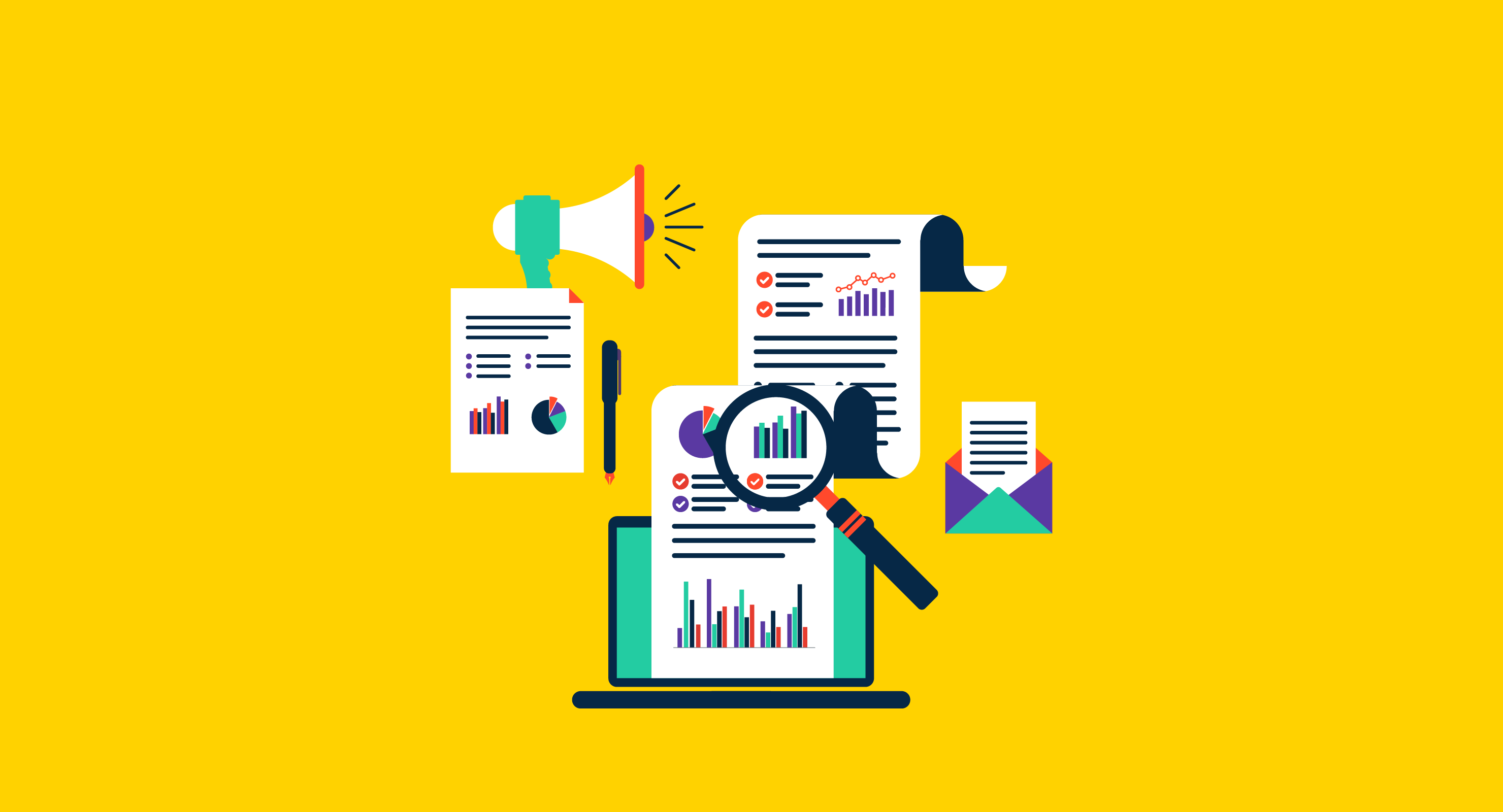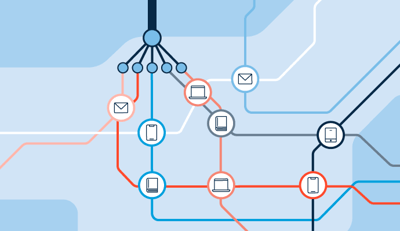

Many of us frequently turn to coffee shops for an afternoon pick-me-up at good ol’ Starbucks.
If you visit often enough, you’re probably signed up for the Starbucks Rewards app, an omnichannel experience that simplifies a wide range of our caffeine cravings. Customers use it to view previous orders, reload their Starbucks cards, find the closest shop, and order ahead to skip the line.
The app is easy to use, offers personalized recommendations, and gives millions of loyal customers an unbeatable integrated experience. In other words, Starbucks has nailed its omnichannel marketing strategy.
Omnichannel marketing is an integrated user engagement strategy wherein brands provide access to their products, offers, and customer service across all platforms, channels, and devices.
Channels span online and offline touchpoints, including websites, apps, social media, email, text messages, retail stores, and events. An omnichannel experience aims to create a cohesive brand experience for customers through marketing, customer service, and personalization techniques.
Effective omnichannel marketing strategies require thoughtful planning and customer journey analysis, as well as the right tools to support your tactics. Many companies use omnichannel commerce software to create uninterrupted buying experiences across channels. These tools centralize product offers within a unified platform to grant businesses with the tools to manage multiple channels simultaneously.
If you’re caught up on your Latin, you know that omni means “all” and multi means “many.” Even so, omnichannel and multichannel are sometimes used synonymously, but they’re different strategies with distinct goals.
A multichannel marketing strategy helps businesses interact with customers through a lot of independent channels. Each channel – brick-and-mortar stores, websites, social media pages, apps, text messages, emails – operates independently. This means that although customers can interact with any of these channels, the encounters may not be cohesive from one channel to the next. Brands might also use strategies and messaging to target consumers. In a multichannel strategy, the siloed separation between channels is intentional.
Omnichannel strategies are customer-centric and utilize multiple channels to provide a seamless and connected customer experience. Omnichannel marketing creates an integrated customer journey as leads move through the buying journey between online and offline channels. A holistic experience marks the cornerstone of an omnichannel strategy.
An omnichannel marketing approach offers many undeniable benefits to businesses and their customers.
An effective omnichannel strategy allows businesses to reach customers wherever they are to lengthen their reach and lead customers along the path to purchase. Forbes described this experience well, noting, “Whether they’re using their smartphone in your store, opening their inbox or browsing social media, your messages get seen.”
A customer can take many routes when considering spending their money on your business. For example, a customer’s path to purchase might include:
With so many different touchpoints involved, customers feel frustrated when the experience is inconsistent or disconnected. They may decide not to complete their purchase or determine that looking elsewhere is less hassle. Omnichannel marketing supports them throughout their buying journey and makes certain that the handoffs between channels are seamless and that each experience is integrated and consistent from start to finish.
Omnichannel marketing strategies create more engaging customer experiences and convert more prospects into loyal customers. According to Loyal Guru, retailers with strong omnichannel marketing capabilities retain 89% of their customers, compared to a 33% retention rate for companies with deficient omnichannel strategies.
Omnichannel loyalty programs play a significant role in this advantage. Consider the Starbucks Rewards app example again. The experience of ordering and paying for a coffee is flawless and users can also earn rewards points every time they make a purchase, eventually earning free products. The easy buying experience, paired with the appeal of free chai lattes, encourages guests to return time after time.
Developing an omnichannel marketing strategy requires time, strategic planning, and understanding Remember, personalization techniques and an integrated customer journey are critical elements of your omnichannel marketing strategy.
If you aren’t sure how to get started, keep reading.
It’s difficult to create an effective omnichannel marketing strategy unless you know who your audience is and where to reach them. Since the omnichannel experience centers customers, a poor or misaligned understanding of your base could lead to an ineffective omnichannel strategy.
So, who are your customers? Through research, market analysis, interviews, previous purchase information, and social listening, you can create buyer personas – fictional profiles of your ideal customers. You might have already defined these or maybe have an idea of what they’ll look like. You could have two personas or ten! It depends on the nature of your company.
Next, with your buyer personas in mind, identify the touchpoints customers navigate throughout their buying journey, from pre-purchase to post-purchase. Every touchpoint counts, so you must document every one of them to locate gaps in the journey that an omnichannel experience may fill in.
To do this, start by aggregating as much data as possible, including online and offline experiences and step-by-step actions that lead to sales. Analyze customer behavior, gather social listening data, and pull data about previous purchasers through analytics and other tools for a complete picture of the customer path. Include the stages, touchpoints, emotions, and gaps in the current state.
Consider buyers’ pain points and ask yourself the following questions:
With your current context, you can now spend time mapping an omnichannel customer journey for each of your buyer personas. Use their preferred channels to complete each stage of the buyer’s journey and consider how you might make those touchpoints personalized.
You might add an additional touchpoint, like an app that connects the journey holistically from start to finish. Or you might realize there’s a gap between your social media profiles and your website that you have to address to ensure consistency. Whatever the case, detail a plan of what you want the customer experience to feel like and what you need to achieve the plan.
Omnichannel strategies succeed when messaging and branding stay consistent across all channels. It’s easy to inadvertently disrupt the customer journey with unclear messaging across platforms. That’s not to say you can't vary the look and feel of your content, but a reader needs to understand that the sale they received an email about is the same one they see on your website a few hours later.
A clear brand style guide, including the brand’s visual identity, style, and tone, sets the stage for creating consistent content across channels. Brands should generate content that matches the buyer’s position on their journey. For example, promoting a “final chance to buy” message on Instagram doesn't make sense if that isn’t the touchpoint where most customers convert.
Brands usually have to experiment to find what works best. Let’s explore an example from Biossance.They shared a text, sent an email, and updated their homepage with similar messaging.
The text message:
The email:
The website:
Potential customers can easily tell that they’re looking at the same campaign across all touchpoints and don’t have to dig to find the 25% discount. Flawless!
Keep your customers at the forefront of your omnichannel marketing strategy by gathering feedback, tracking performance metrics, and using this information to understand where you can improve. As your customers change over time, your omnichannel strategy should follow. Be flexible, adapt to changing customer behavior, and experiment with new ideas for the best results.
Don’t start from scratch. Learn a lesson or two from brands that nail the omnichannel experience. These brands prioritize omnichannel strategies and do it well.
Recreational Equipment, Inc. (REI) provides quality gear, apparel, and rental equipment for outdoor adventures. Customers can shop REI online or take advantage of their services and expert advice at one of their stores.
Members who join the REI Co-op membership earn rewards, receive coupons, and get free standard shipping in the US, among many other exclusive benefits. A few weeks ago, many of REI’s customers received 20% off coupons with a sneak peek of early access deals for members only. On the back of the mailer, the company listed the addresses of local REI stores. Customers can also open the REI app, see a reminder about the member coupons, view available stock via the app, coordinate curbside pick-up, or have items shipped for free.
REI does a fantastic job of ensuring that its channels work together to create a great customer experience, especially for Co-op members.
Source: REI
IKEA, Sweden’s home furnishings brand known for affordability and design across the globe, does excellent omnichannel marketing. In an interview with Google, chief digital officer for Denmark Karen Helweg and country marketing manager for Belgium Grégory Bauduin discussed their success.
They highlighted that customers love the IKEA experience, which almost always involves a half-day of exploring the store and stopping at the food court for meatballs. To build on the in-person shopping experience and provide customers with more control, IKEA prioritized the following:
Read more about IKEA’s omnichannel ecosystem in Atcom’s case study.
Source: IKEA
Omnichannel marketing experiences enhance the customer journey by providing an integrated experience across all channels, no matter how many a brand uses. Brands have turned to omnichannel marketing to expand their reach, engage customers through a seamless journey, and turn potentials into loyal, lifelong fans. To do this effectively, you need to know who your customers are, where you can improve your current journey, and how to create cohesive, omnichannel content that customers love.
Level up your customer support touchpoints with a chatbot as part of your omnichannel strategy. Learn how to build a chatbot from scratch.

Find the right omnichannel commerce software to create a seamless buying experience for your customers.
Alyssa Towns works in communications and change management and is a freelance writer for G2. She mainly writes SaaS, productivity, and career-adjacent content. In her spare time, Alyssa is either enjoying a new restaurant with her husband, playing with her Bengal cats Yeti and Yowie, adventuring outdoors, or reading a book from her TBR list.

Find the right omnichannel commerce software to create a seamless buying experience for your customers.
Customer experience has become one of the most important factors that determine the long-term...
 by Marilia Dimitriou
by Marilia Dimitriou
Consistency is the key to everything.
.jpg?width=400&height=150&name=G2Headshots_Aayushi_Sanghavi_ZOE1415-Edit%20(1).jpg) by Aayushi Sanghavi
by Aayushi Sanghavi
Decoding the retail puzzle for businesses.
 by Téa Liarokapi
by Téa Liarokapi
Customer experience has become one of the most important factors that determine the long-term...
 by Marilia Dimitriou
by Marilia Dimitriou
Consistency is the key to everything.
.jpg?width=400&height=150&name=G2Headshots_Aayushi_Sanghavi_ZOE1415-Edit%20(1).jpg) by Aayushi Sanghavi
by Aayushi Sanghavi
Never miss a post.
Subscribe to keep your fingers on the tech pulse.



